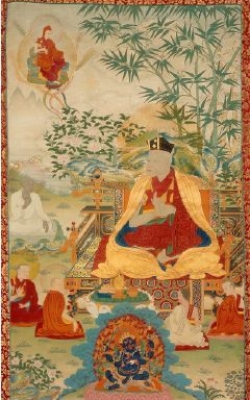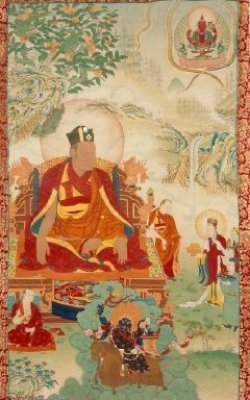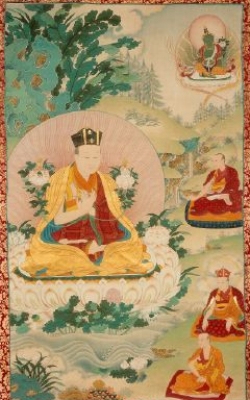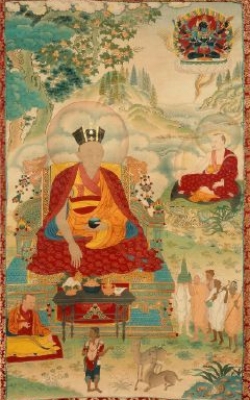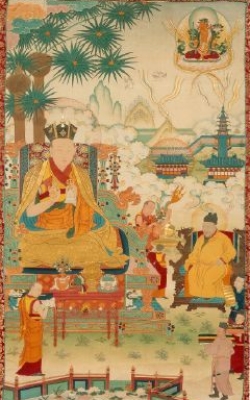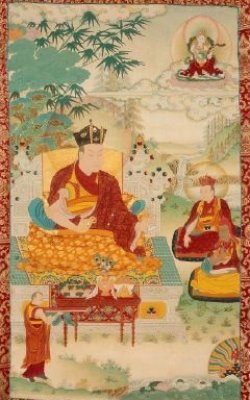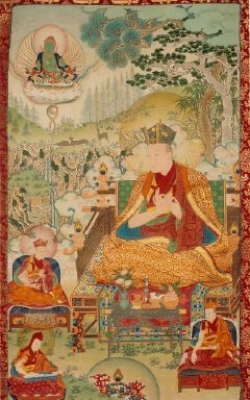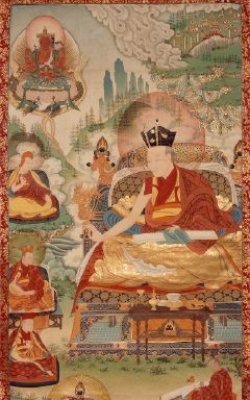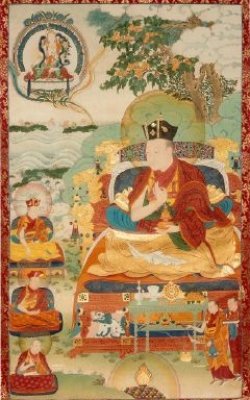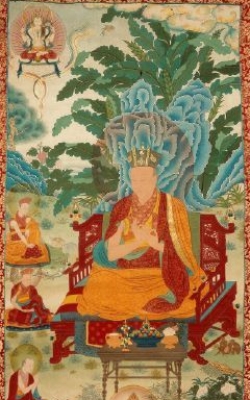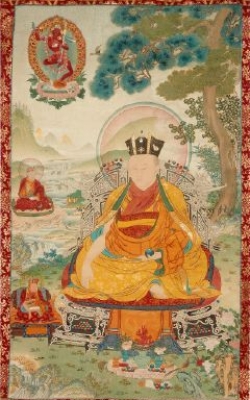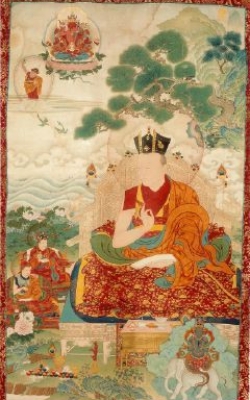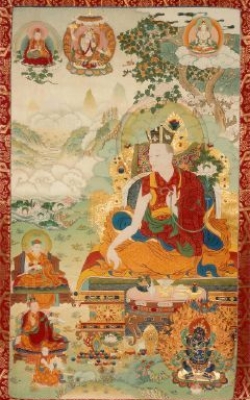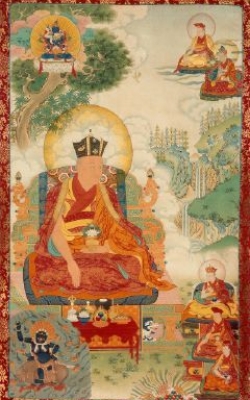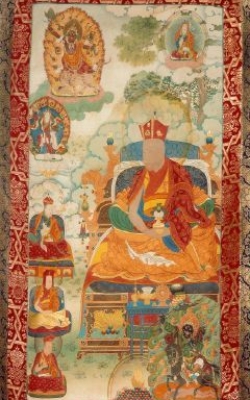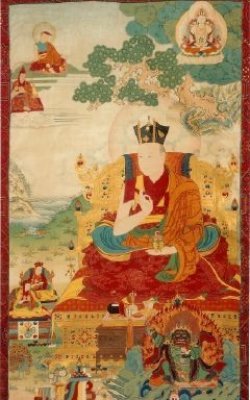Karmapa XVI - Rigpey Dorje
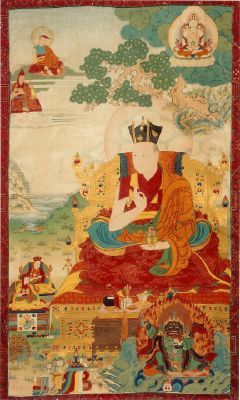
THE XVIth KARMAPA
(1924 - 1981)
The sixteenth Karmapa, Rangjung Rigpe Dorje, was born at Denkhok in the Dege region of Kham near the river Yangtse, on the full moon day of the sixth month of the year of the Wood Mouse (1923 C.E.). He was born into an aristocratic family named Athub. His father's name was Tsewang Norbu and his mother's Kalzang Choden. The birth of a great bodhisattva in the Athub family had been previously predicted by Dzok Chen Tulku, Chokyi Dorje, head of the famous Nyingma monastery of Dzok Chen. Acting on his advice, the mother had given birth in the nearby cave of Padmasambhava, called the Lion Sky Castle.
Before the child's birth he disappeared entirely from the womb for one whole day and then returned the next. On the actual night of his birth: the atmosphere was charged with portents, which everyone in the locality could sense.
Shortly afterwards, Situ Padma Wangchuk Gyalpo opened the previous Karmapa's letter of prediction and discovered therein a detailed description of the house in which Rangjung Rigpe Dorje's parents dwelt. A search party was sent, and the child was speedily recognized to be the sixteenth Karmapa incarnation.
When he was seven years old he received the novice ordination from Situ Rinpoche and from Jamgon Kongtrul of Palpung. A year later the vajra crown and the robes of the Karmapa were brought from Tsurphu to Kham for him. Situ Rinpoche then invited him to visit Palpung monastery.
On the way there, Karmapa's party was met by the prince of Dege, Tsewang Dudul, who requested Karmapa to visit his palace. This palace, Dege Lhundrup Teng, which was built by the fifteenth century Nyingma saint, Thangtong Gyalpo, was near Dege Gonchen, the main monastery of the Sakya Ngorpa lineage. While in Dege, Rangjung Rigpe Dorje visited and blessed the monastery's huge printing press. A little later the party travelled on to Palpung, where the young Karmapa was given a great welcome. Four days later he was enthroned by Situ Rinpoche in the main shrine of the monastery.
On the twenty-third day of the fourth month of the Iron Sheep year, Rangjung Rigpe Dorje and Situ Rinpoche, accompanied by a monastic camp of a thousand people called Karmapa garchen, set out for Tsurphu. Along the way, Rangjung Rigpe Dorje performed the vajra crown ceremony for the first time in his lifetime at Gyina Gompa in Nangchen. After this auspicious event, the party visited Nyenchen Thanglha, an environment symbolically dedicated to the energy of the Karma Kagyu tradition. On his subsequent arrival at Tsurphu, Karmapa was welcomed by Palpung Kongtrul Rinpoche, Pawo Rinpoche and Cryaltshap Rinpoche.
After a short period of time Rangiung Rigpe Dorje visited the thirteenth Dalai Lama in Lhasa, from whom he received the "hair cutting" ceremony. During this ceremony, the Dalai Lama, Thubten Gyatsho, perceived the vajra crown, woven from the hair one hundred thousand dakinis, above the head of Rangjung Rigpe Dorje. After his return to Tsurphu, Karmapa was given a second “golden throne ceremony" by Situ Rinpoche and Drukchen Rinpoche, Mipham Chokyi Wangpo, head of the Drukpa Kagyu sect.
For the next four years Rangjung Rigpe Dorje studied with Beru Khyentse Rinpoche and Bo Kangkar Mahapandita, who was acclaimed as the last great Kamtshang Kagyu scholar of the time. Kangkar Rinpoche had memorized the entire contents of the Tripitaka and numbered among his students the profound contemporary Sakya scholar, Dezhung Rinpoche, as well as the eminent translator, Garma C. C. Chang. While studying with Kangkar Rinpoche, Karmapa related the stories of his previous lives to his guru.
In 1937 Rangjung Rigpe Dorje and his entourage set out on a journey to Dege in Kham, to visit Situ Rinpoche. On the journey many highly symbolic events took place which conveyed the inspiration of Karmapa’s energy. Karmapa was invited to visit the king of Nangchen's palace and Tsechu Gompa, the Drukpa Kagyu monastery under the patronage of the king. He also visited Kaycha Gompa, a Drukpa Kagyu convent in Nangchen housing nine hundred nuns, the largest convent in Tibet.
ln the area of Drong Tup there is a small lake in which it is said that Rangjung Rigpe Dorje left footprints in the water, which may be seen by anyone, even in winter when the lake is frozen. At Riwa Parma monastery as Karmapa performed the rituals of the wrathful Padmasambhava festival, fire flamed from the tormas ("offering cakes").
A little later Karmapa visited the monastery of the nineteenth century master, Chogyur Lingpa, the last great terton. There Lama Samten Gyatsho requested Karmapa to bring an end to the drought that was afflicting the monastery. In response, Rangjung Rigpe Dorje asked for some water in which to wash himself. As he bathed it started to rain and a spring came up under the washtub.
When Karmapa finally arrived at Palpung monastery he was welcomed by Situ Rinpoche. Subsequently, Situpa instructed his student in Kongtrul Lodro Thaye's profound works, the Kagyu Ngagdzod, which contains the advanced tantric teachings of Marpa Lotsawa, and the Dam Ngagdzod. containing the advanced teachings of the eight original Tibetan Buddhist sects. On a visit to Pangphug monastery, Karmapa and Situ Rinpoche left their footprints in stone. While outside the temple, Rigpe Dorje's dog and horse also left clear footprints in the rock.
After a short meditation retreat, Karmapa and Situ Rinpoche received an invitation to visit China from General Chang Kai Shek. However, Karmapa did not accept the invitation personally, choosing instead to send Beru Khyentse Rinpoche as his representative.
At the Dzongsar monastery of Khyentse Chokyi Lodro, the great Rime scholar, Rigpe Dorje performed the vajra crown ceremony. Khyentse Rinpoche envisaged the spiritual form of the vajra crown floating about eighteen inches above Karmapa's head. In addition, he saw Karmapa in the form of Dusum Khyenpa. On his return to Palpung, Rigpe Dorje received the empowerments, textual transmissions and instructions of the collected spiritual practices of the Sakya tradition (T'ib:སྒྲུབ་ཐབས་ཀུན་བཏུས).
In the ninth month of the year of the iron Dragon (1940), Karmapa began the journey back to Tsurphu. On the way, he visited Benchen monastery, where, on his arrival, a statue of the horse on which the dharmapala Zhingchong (Tib,: ཞིང་སྐྱོང་) was seated began to neigh. After a journey lasting eleven months, Rigpe Dorje and his entourage reached Tsurphu. For the next three years. Karmapa entered into intensive practice, while new construction work was carried out on the monastery. I n 1944 he went on a pilgrimage, first to Samye monastery and then on to Lhodrak, the home of Marpa Lotsawa. That same year Rigpe Dorje was invited to visit Bhutan at the request of the second king, Jigme Wangchuk. During his stay he performed the vajra crown ceremony several times and gave many empowerments.
In the following year the aged Situ Rinpoche travelled to Tsurphu to give further teachings to his spiritual son. The twenty-two year old Rigpe Dorje received full ordination as a monk from Situpa. In addition, his guru instructed him in the Gyachen Kadzod collection of Kongtrul Lodro Thaye and the Chigshe Kundrol. From Urgen Rinpoche, Karmapa received the complete empowerments and textual transmissions of Terton Chogyur Lingpa’s teaching.
In the fourth month of the year of the Fire Pig ( 1947) Karmapa journeyed to western Tibet and from there on to India and Sikkim. In Nepal he performed the vajra crown ceremony and gave his blessings to the people. Rigpe Dorje then travelled to Lumbini, the birthplace of Sakamuni Buddha. He also visited Varanasi, the site of Sakyamuni’s first sermon and Bodhgaya, the place of his enlightenment. At the invitation of the maharaja of Sikkim, Tashi Namgyal, Karmapa visited Gangtok, where he performed the black crown ceremony and gave empuwerments.
Rigpe Dorje then travelled to Rewalsar (Tib:མཚོ་པད་མ) in India, which is sacred to Padmasamhhava. Many white snakes appeared on the surface of the lake there and this was regarded as a very auspicious event. During the long journey back to Tsurphu he passed through the area of Mount Kailasa and Lake Manasarowar. Finally Karmapa and his party arrived back in Tsurphu in the eleventh month of the year of the Earth Rat (1948).
Rigpe Dorje invited Jamgon Kongtrul of Palpung to come to Tsurphu and give him further teachings. Kongtrul Rinpoche gave him the Rinrhen Terdzod, and, in addition, instructions in mahamudra and the six yoga: of Naropa. At the completion of his studies, Rigpe Dorje received the textual transmission of the lineage from Kongtrul Rinpoche and Situ Rinpoche. To celebrate Karmapa's mastery of mahamudra, Palpung Kongtrul composed a poem in which he praised him as being a perfect holder of the mahamudra lineage. During this period an outbreak of smallpox reached epidemic proportions but was brought under control as a result of a Vajrakilaya exorcism performed by Karmapa.
In the early years of the 1950s Karmapa carried on his teaching and administrative duties both in Tsurphu and in other parts of the country. In 1953, Rigpe Dorje gave the empowerments and textual transmissions of Dechen Chogyur Lingpa's Terma teaching to Mindrol Ling Chong Rinpoche, who as head of the Mindrol Ling monastery was in effect the senior lama of the Nyingma tradition.
ln 1954 the Chinese authorities in Peking invited His Holiness the fourteenth Dalai Lama, and the heads of the other Tibetan religious traditions, together with of her dignitaries, to visit Peking and other parts of China, His Holiness Karmapa accepted the invitation and, together with the rest of the party, travelled to Peking, While there, Karmapa received a visionary intimation from Mahakala indicating the circumstances of the rebirth of Situ Rinpoche. He was able to send a letter to Palpung describing the whereabouts of the Situ incarnation. On the return journey, Karmapa formally enthroned the new Situpa at Palpung. He also travelled extensively throughout Kham as the personal ambassador of the Dalai Lama in an attempt to restore calm to an increasingly worried populace. Many Kagyu lamas and students came to Karmapa while he travelled, to receive empowerments and ordinations.
Following his return to Tsurphu, Karmapa supervised the construction of a residence for His Holiness the Dalai Lama, whom he invited to visit. The Dalai Lama and his entourage were greeted with great festivities and he was requested to give the empowerment of the one thousand armed Avalokitesvara. In return the Dalai Lama asked Karmapa to perform the ceremony of the vajra crown. During the visit Rigpe Dorje showed the Dalai Lama the wealth of relics collected at Tsurphu and a ritual Padmasambhava dance was held in his honor.
In the same year, 1955, serious hostilities broke out in the Dege and Nangchen districts of Kham. Karmapa visited Chamdo, where he tried to bring about peace between the Khampas and the Chinese forces. Both sides promised to keep a five year truce.
In 1956 His Holiness visited Druk Dechen Chokhor Ling, the principal Drukpa Kagyu monastery. He gave teachings and also performed a purification rite. From there he travelled on to Sikkim, where he again met the king, Tashi Namgyal. The year 1956 was celebrated worldwide as the twenty-live hundredth anniversary of Lord Buddha's parinirvana, so Karmapa and his party extended their journey into India and Nepal, where they visited all the sacred places of pilgrimage. From Nepal, Rigpe Dorje returned to India and the famed Ajanta caves, which contain Buddhist carvings made during the Gupta dynastic period. In Kalimpong, Karmapa met with Her Royal Highness Azhi Wangmo, the Bhutanese princess, who undertook to build a monastery for His Holiness in eastern Bhutan. At this time, Rigpe Dorje was asked to visit Rumtek monastery in Sikkim, which had been established during the lifetime of the ninth Karmapa. However, he declined the invitation, saying that he would he coming to it in the future, when he had need of it.
When Rangjung Rigpe Dorje returned to Tsurphu early in 1957, serious hostilities had broken out again in Kham. A stream of refugees was pouring into central Tibet. Among these refugees were many Kagyu lamas such as the ninth Sangye Nyenpa Rinpoche, Situ Rinpoche, Talep Rinpoche and their followers who came to Tsurphu. During this time Karmapa recognized the twelfth Gyaltshab incarnation the new Palpung Kongtrul Rinpoche, and Bongsar Khyentse, Rinpoche. From Zechen Kongtrul, Karmapa himself received the textual transmissions and teachings of the Longchen Dzodun, the profound seven volume work of Longchenpa, which deals with maha ati.
Inexorably, the conflict spread from Kham into central Tibet. Karmapa sent Situ Rinpoche, Sangye Nyenpa Rinpoche and the venerable meditation master, Kalu Rinpoche, to Bhutan. The young Palpung Jamgon Kongtrul was sent to Kalimpong in India to stay with his family, wealthy merchants, the Sandu. However, Karmapa himself decided not to leave at that time, saying that he would come to Bhutan if the situation deterioriated. It was his intention to stay behind in Tsurphu until the last possible moment in order to render assistance to the refugees.
The hostilities between the Chinese Communist army and the Khampa resistance were now raging throughout Tibet. From all appearances the ancient Buddhist culture of Tibet was about to be extinguished like the light of a lamp. Realising that he must leave Tibet now, in order to help preserve buddhadharma, Rigpe Dorje informed the Dalai Lama of his plans. Subsequently, in the middle of the fourth night of the second month of the year of the Earth Pig (1959), Karmapa, dressed in lay clothing, together with a party of one hundred and sixty people, left Tsurphu, carrying some precious relics and shrine implements that were light in weight. The party included incarnate lamas, monks and lay people. With Karmapa were the thirteenth Shamar Rinpoche, the twelfth Gyaltshab Rinpoche, the meditation master, Drupon Tendzin Rinpoche, Dabtrul Rinpoche, Khandro Chenmo, the saintly fourth consort of Karmapa Khakhyab Dorje, and others including His Holiness's general secretary, Dorje Lopon Topga Rinpoche and the author.
The party's escape route lay over the Himalayas into Bhutan. However, the food supply was only sufficient for two weeks. Karmapa's party passed through southern Tibet and the local people gave much assistance to the refugees. Fleeting visits were paid along the way to Marpa Lotsawa's house in Lhodrak and also to a Milarepa shrine, the famous nine story tower built at Marpa Lotsawa’s direction, where His Holiness gave the Milarepa initiation and performed the sadhana.
As the group reached the last snow pass, Mon La Gar Chung (elevation 19,855 ft.), which marks the Tibet-Bhutan border, Karmapa urged everyone on, saying that they must cross the pass that same day. The party expended their last energy in crossing over into Bhutan, assisted by guides from the local people. During the following night there was a great snowfall, which blocked all the passes for two or three days. In fact, the military forces had been in close pursuit of the refugees, and had they not done as Karmapa directed they would have been captured.
Twenty-one days after leaving Tsurphu, Karmapa and his party arrived in the Bumthang district of Bhutan, the land said to hear the footprints of one hundred thousand dakinis. He was given a very warm welcome by the Bhutanese princess and nun, Azhi Wangmo, and others. Kalu Rinpoche, together with his monks, came to visit Karmapa in Tashi Chodzong, as did Situ Rinpoche. Having visited King Jigme Dorge Wangchuk in Thimphu, the Bhutanese capital, Karmapa decided to move on into India.
At Baxa, on the border of Bhutan and India, His Holiness met with the Sikkimese Prime Banya Sahib Tashi Dadul, who conveyed the maharaja's invitation to Karrnapa to reside in Sikkim. Karmapa decided to accept the invitation, and on the twenty-filth day of the fourth month of the year of the Earth Pig (1959) he and his party went to Gangtok, the sikkimese capital. Karmapa was warmly welcomed by the royal family and the people, and was asked where he would like to settle. He replied that as Tibetan refugees they hoped one day to be able to return to Tibet. Therefore, their residence would in one sense be only temporary. However, as the ninth Karmapa, Wangchuk Dorje had commissioned the building of Rumtek monastery, he, the sixteenth Karmapa, would like to establish his seat-in-exile there.
Following his arrival at Rumtek, Karmapa ceremonially, enthroned Palpung Kongtrul Rinpoche and bestowed many empowerments upon him. That winter (1959-60), Rigpe Dorje visited India, where he first met His Holiness the Dalai Lama in Benares and later Pandit Nehru, the then prime minister, who was very sympathetic both to Buddhism and the plight of the Tibetan refugees. In the summer Karmapa gave many empowerments to large numbers of people who flocked to see him. Large sums of money were donated to Karmapa from the Sikkimese and Indian governments to aid in the construction of a new monastery, situated on seventy acre of land near the old Rumtek monastery. The site chosen had many auspicious signs: seven hill facing, seven streams flowing toward it, a mountain behind it, snow mountains in front of it, and a river below, twirling in the shape of a conch shell. The great enthusiasm for the work among Karmapa's followers meant that the construction was accomplished in four years.
During this period His Holiness recognized the new Drukchen Rinpoche, Drukpa Yongdzin Rinpoche. Dzigar Choktor Rinpoche, Sangye Nyenpa tulkus, Surmang Garwang Rinpoche, Drongram Jatrul, the new Dzok Chen Ponlob incarnation and Drupon tulku Chogyur Lingpa.
Up to the present time His Holiness Karma pa has ordained more than 3,000 monks and recognised hundreds of tulkus. He has caused to be published a new printing of the Dege Kanjur, the basic encyclopedia of Buddha's teaching. In a gesture of interdenominational cooperation and fellowship, he has distributed 170 sets to institutions of all four sects of Tibetan Buddhism and to representatives of the Bonpo faith. His Holiness has made two extended trips around the world. Several of his own Karma Kagyu lamas have established dharma centres in the West, and His Holi-ness has toured them and given teachings.
This has been a concise account of the lives of the sixteen Karmapas. For more detailed accounts one should consult the original records and biographies. However, in the final analysis all records are limited. The Karmapa's unborn nature, knowing past, present and future, perfectly realising the teachings of dharma, and effortlessly radiating the liberating power of compassion, completely transcends the network of concepts.
Reproduced with permission of the Very Venerable Karma Thrinley Rinpoche.




